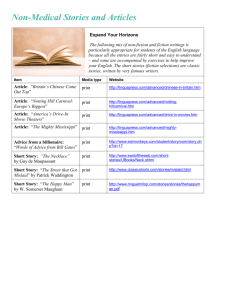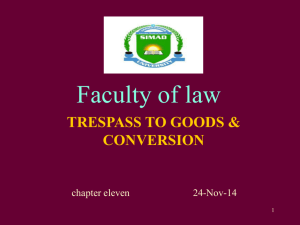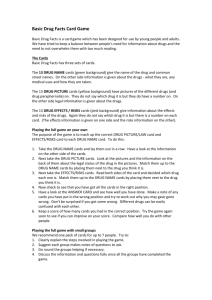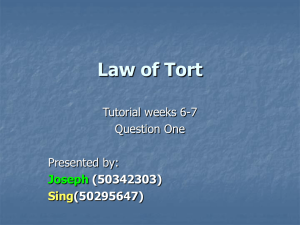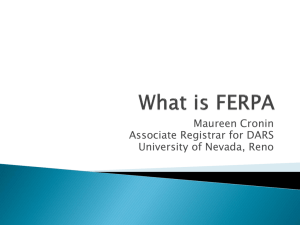Part Two: An Introduction to Personal Property
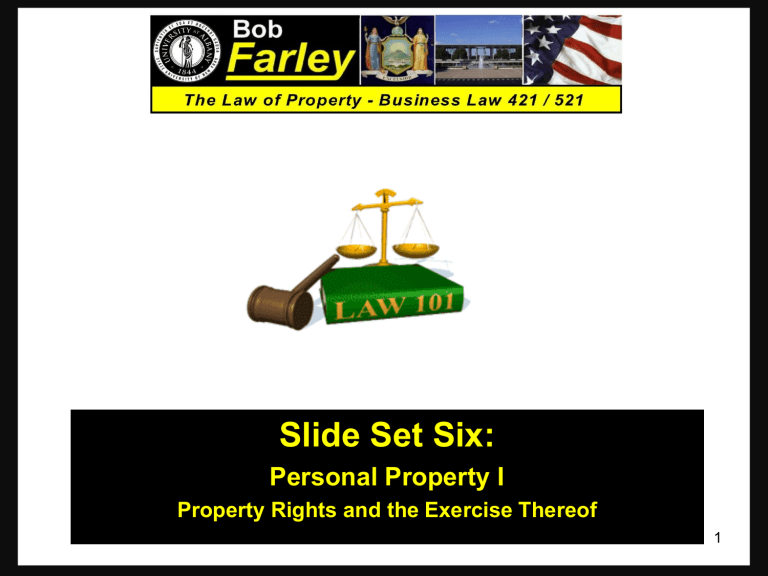
Slide Set Six:
Personal Property I
Property Rights and the Exercise Thereof
1
Last Time – We Spoke About:
•
The Definition of Property
•
The Evolution of Property Rights in Law
How the Law and Property are Intertwined
•
The Constitution and Declaration:
How Property Rights Are A Part of America
•
The Four Postulates:
Property is a Collection of Rights NOT a collection of things;
Property Rights are those recognized by Law, and Property
Rights and the Law are intertwined and evolved from each other;
Property Rights are inherent to our humanity, and are legally endowed to us by our Creator; and
Property Rights can be Summarized by EPUT:
The Rights to Exclude; Possess, Use and Transfer.
2
Tonight – We Will Speak About:
• Part One: A Review of Property Rights
• Fundamental Principles.
• Part Two: Introduction to Personal Property
• An introductory discussion on Personal Property; and
• Part Three: The Exercise of Property Rights
• Acquiring and losing the Rights, Ownership, and
Possession of Personal Property.
3
Part One:
A Review of Property Rights
4
Part One: A Review of Property Rights
A. What is a “Right” with Respect to Property?
Black’s Law Dictionary defines the term “Right” as:
1. Powers of free action
… a capacity residing in one man of controlling, with the assent and assistance of the state, the actions of others.
2. A power, privilege or immunity guaranteed under a constitution, statutes or decisional law, or claimed as a result of long usage.
Basically, it’s the legally recognized ability to exercise Power and Control over the Property .
5
Part One: A Review of Property Rights
B. Why are Property Rights Important?
Viewing property as a collection of rights rather than a collection of things serves a dual purpose .
- FIRST: The Value -
• The essential element which gives property its value, is not the item itself, but rather the ability to control the item.
This issue of control is reflected by an analysis of rights.
- SECOND: Allows the Inclusion of All Types of Property Interests
• It is only through a perspective of rights, that we are able to broaden our concept of property, to include many of the more abstract property interests of great value to modern society.
Concepts such as intellectual property, future interests, and non possessory interests, do not lend themselves to be easily considered as “tangible items”, and as such, are property interests best viewed through the context of rights.
Accordingly , by employing this “rights” perspective, a more inclusive and accurate picture of what property actually is, and means, can truly be had.
6
Part One: A Review of Property Rights
C. The Four Fundamental Postulates of Property Law
1 . Property needs to be seen as a collection of “Rights” not a collection of “Things”;
2. Property Rights are those recognized by Law and the Law evolved from Property Rights;
3. Our Foundations of Law recognized that we are endowed with Property Rights; and
4. Property Rights can be summarized by E-PUT
The RIGHT to EXCLUDE
The RIGHT to POSSESS
The RIGHT to USE; and
The Right to TRANSFER.
7
Part One: A Review of Property Rights
D. Ways to Exercise Property Rights: EPUT
1. The Right to Exclude:
The right to exclude others from the use or occupancy of the particular “thing.”
2. The Right to Possess:
The right to possess is the right to hold, control or enjoy the particular “thing”.
3. The Right to Use:
The right to use a particular “thing”, enjoys broad discretion under the law for all types of usages, so long as it does not interfere with the free use of another’s property (i.e. nuisance). This also includes the right NOT to use.
4. The Right to Transfer:
The right to transfer property rights of the particular
“thing” can be accomplished by sale, gift, or bailment (loan), during ones lifetime, or by means of bequest after death pursuant to intestate or will.
8
Part One: A Review of Property Rights
E. Types of Property
• What Types of Property can “Rights” be exercised over:
– Real (Rights in Land);
Real Estate – Ownership/Leaseholds/Easements/Life Estates
– Personal (Rights in Objects); and/or
Chattels – Tangible, visible “things”
– Intellectual (Rights in Ideas)
Patents – Idea for Product or Process
Trademarks – Logo, Identification or Distinction
Copyrights – Written or Performed Works
9
Part Two:
An Introduction to
Personal Property
10
Part Two: An Introduction to Personal Property
A. So just what is Personal Property?
1. Common Law (case law) Definitions:
• Real property land, things fixed to land. and things incidental or appurtenant to land (basically immovable property).
• Personal property movable property, but includes virtually every kind of physical property that is not real property. (Such as goods, chattels, money, notes, stocks, and animals).
11
Part Two: An Introduction to Personal Property
A. So just what is Personal Property? (Continued)
2. Statutory Definitions
Section 3-5.1 of the New York Estate Powers and Trusts Law defines:
• Real property -
“land or any estate in land, including leaseholds, fixtures, and mortgages or other liens thereon.”
• Personal property -
”any property other than real property, and includes tangible and intangible things.”
12
Part Two: An Introduction to Personal Property
A. So just what is Personal Property?
3. Conversion Between Real and Personal Property:
Pursuant to New York State Law Real and Personal Property can be converted
Between the two types.
• Real to Personal:
Real property may be converted to personal property by severance
• Personal to Real:
Personal property may be converted to real property by an attachment or by annexation which is intended to be permanent.
(i.e. fixtures).
13
Part Two: An Introduction to Personal Property
A. So just what is Personal Property?
4. Real and Personal Property Distinctions - Leases
• Under the common law, a lease of land for a term of years constituted personal property.
• This was because the lease did not fall within the common law definition of land, tenements, or hereditaments.
• A lease was considered an interest in land less than a freehold and therefore a real chattel.
• Modern statutes changed the common law rule for leases, defining them as real property.
14
Part Two: An Introduction to Personal Property
A. So just what is Personal Property?
5. Real and Personal Property Distinctions – Crops a. Fructus Naturales
Crops that grow spontaneously on land, e.g., trees, bushes, and grass, are described as fructus naturales and are considered to be a part of the land, and therefore real property .
As a result, title to the land would include these naturally occuring crops.
b. Fructus Industriales
Crops that are the result of annual planting, labor, and cultivation. (e.g., grains, vegetables, and other crops, are described as fructus industriales.)
These crops, as a general rule, are regarded as personal property .
15
Part Two: An Introduction to Personal Property
A. So just what is Personal Property?
6. Real and Personal Property Distinctions – Fixtures
• Under the concept of fixtures, a chattel that has been annexed to
real property is converted from personalty to realty.
• The former chattel becomes an accessory to the land (i.e., a fixture) and passes with ownership of the land.
• We will explore this concept more in during real property. Simply know for now, that if personal property is permanently attached to
real property, it becomes a fixture and becomes part of such real
property.
16
Personal Property
Just how are Rights and Title in Personal Property Acquired or Lost?
17
Part Three: The Exercise of Property Rights
A. The Acquisition and Loss of Right or Title to Personal Property
• Rights and Title to Personal Property are Acquired or Lost by:
1. Occupancy/Possession,
2. Transfer by Sale,
3. Adverse Possession,
4. Accession,
5. Confusion,
6. Judgment,
7. When the chattel is lost, mislaid, or abandoned, or
8. Gift
18
Part Three: The Exercise of Property Rights
A. The Acquisition and Loss of Right or Title to Personal Property
• Its all about the PROOF:
• Since the exercise of property rights is the legal ability to exercise dominion and control over the property in question, the legal recognition of such right has led to elements of proof.
• Such elements are proven by means of demonstrating the methods of acquisition or loss of the item of property itself.
19
Part Three: The Exercise of Property Rights
A. The Acquisition and Loss of Right or Title to Personal Property
1. Occupancy/Possession
- Generally:
• Remember property rights are the legally recognized ability to exercise power and control over the property.
• The law seeks to have property to be owned by someone.
• As such, the law recognizes that a thing capable of ownership, but not yet owned, will belong to the person who acquires actual or constructive dominion or control over it, and who has the intent to assert ownership over it. (i.e. possession).
• Occupancy/Possession is this actual or constructive dominion or control.
• Hence the well known adage: Possession is 9/10ths of the law .
20
Part Three: The Exercise of Property Rights
A. The Acquisition and Loss of Right or Title to Personal Property
1. Occupancy/Possession (Continued)
- Special Rules: Wild Animals
•
Wild animals (ferae naturae) in their natural state are unowned.
•
They become private property upon being reduced to possession.
Acquisition of Title and Possession
•
An animal in its natural state is unowned.
•
The first person to exercise dominion and control over such animal becomes, with possession, the owner of it.
• To become the owner, the claimant must establish that they have exercised dominion and control over the animal. (Pierson v Post)
Acquisition of Title - Constructive Possession
Animals caught in a trap or net belong to the one who owns and has set the trap or net. By setting such a trap, one is said to constructively possess those animals snared.
21
Part Three: The Exercise of Property Rights
A. The Acquisition and Loss of Right or Title to Personal Property
1. Occupancy/Possession (Continued)
- Special Rules: Wild Animals (Continued)
• Wild animals (ferae naturae) in their natural state are unowned.
•
They become private property upon being reduced to possession.
Mere Pursuit
Mere pursuit does not constitute the exercise of dominion and control sufficient to give the hunter a property right in the animal. However, where an animal has been
mortally wounded so that actual possession is practically inevitable, a vested property right in the animal accrues and cannot be divested by another's intervening act in killing the animal.
Violation of Statute
One who violates a statute (e.g., fails to have a hunting license) forfeits his title in animals caught pursuant thereof. One who violates a statute (e.g., fails to have a hunting license) forfeits his title in animals caught or killed.
Trespass
While a landowner is not regarded as the owner of all wild animals found on their property, a trespasser who kills game on another's land forfeits title in favor of the landowner. This rule does not change the fact that the animal is unowned until reduced to possession. In order not to give a benefit to the act of trespassing,
Part Three: The Exercise of Property Rights
A. The Acquisition and Loss of Right or Title to Personal Property
1. Occupancy/Possession (Continued)
- Special Rules: Wild Animals (Continued)
Escape
If a wild animal, captured and held in private ownership, escapes and resumes its natural liberty, the former owner loses thier property right in it. The animal is once again unowned and the first person thereafter to capture it becomes the owner.
Habit of Return
If a wild animal escapes and, although wandering about without restraint, retains a habit of periodic return to its master's home, or if, although endeavoring to escape, is still pursued by the owner or is by other means liable to be recaptured by its owner, title is not lost.
Marked Animals
When animals have been captured and reduced to private ownership, it is common for the owner to mark or brand them for purposes of identification.
If the animal escapes and resumes its natural liberty, the question becomes if title is lost.
Normally, modem courts will allow title to be retained in the former possessor as long as the animal is marked and the owner exercises all possible effort to recapture the animal.
23
Part Three: The Exercise of Property Rights
A. The Acquisition and Loss of Right or Title to Personal Property
1. Occupancy/Possession (Continued)
- Special Rules: Tortious Conversion
1. True Owner Retains Title
Tortious conversion of personal property does not deprive the true owner of their title.
Moreover, one who does not have title to goods cannot pass title to even a bona fide purchaser.
2. Exceptions
A bona fide purchaser can obtain good title from one without title where: a) The owner of goods, induced by fraud or misrepresentation, sells goods to the defrauder
intending to transfer title, and defrauder subsequently sells the goods to a bona fide purchaser; b) Money or a negotiable instrument is transferred; or c) The owner of goods has expressly or impliedly represented that the possessor of goods is the owner, or has authority to sell them, and the BFP has relied in good faith on the representations.
Divestment of Property
• One attempting to divest another of personal property has the burden of showing title and the right to divest.
• Any evidence is admissible, and ownership may be established by proof of acts of ownership as well as by direct testimony.
• Possession plus a claim of title is prima facie evidence of title and ownership.
24
Part Three: The Exercise of Property Rights
A. The Acquisition and Loss of Right or Title to Personal Property
2. Transfer by Sale
- Rules: Sale of Personal Property
• Title can be acquired or lost to personal property through a valid sale.
•
A Sale is the transfer of the Rights in the Property in return for Consideration.
• In general, an owner of personal property cannot be divested of their Rights and
Title without their consent.
•
A purchaser of a chattel acquires Rights and Title by voluntary act. (Conduct creating an estoppel can force sale by operation of law).
• The intent of the parties is controlling in determining what goods pass and when
Rights and Title passes in a sale.
• Pursuant to the UCC, a sale of goods in excess of $500 must be in writing and signed by the party to be charged in order to be enforceable. (UCC 2-201)
25
Part Three: The Exercise of Property Rights
A. The Acquisition and Loss of Right or Title to Personal Property
3. Adverse Possession
- Rules: Adverse Possession of Personal Property
•
Title to personal property by adverse possession results from the running of a statute of limitations which requires that the cause of action for recovery of the property be brought within a specified period after the cause of action accrues. (See CPLR
– Article 2)
• When the specified period has run, the presumption that the person in possession has the right to possession cannot be overcome by the former owner.
• As a result, the party in possession thereafter has an enforceable right to possession superior to everyone and thus becomes the true owner.
26
Part Three: The Exercise of Property Rights
A. The Acquisition and Loss of Right or Title to Personal Property
4. Accession
- Rules: Accession a. Accession Defined
Accession is:
“The addition of value to property by the expenditure of labor or the addition of new material.” b. Accession Remedies
Detachment
• If the added article can be detached from the principal chattel, this will be ordered and each party will be put in status quo ante.
Detachment Unavailable
• If the added expenditure or thing cannot be detached from the principal chattel, the question arises as to who is the owner of the chattel in its enhanced state.
This will require a determination of value. This answer will depends upon whether the trespasser acted in good faith or is a willful trespasser.
27
Part Three: The Exercise of Property Rights
A. The Acquisition and Loss of Right or Title to Personal Property
4. Accession (Continued)
- Rules: Accession (Continued) c. Accession Rules
1. General Rule -Trespasser Cannot Recover
• The owner of a chattel does not lose their title merely because a trespasser has augmented or enhanced the value of that chattel.
• Generally, authorities refuse to recognize any quasi-contractual claim to compensation by the innocent trespasser – but there are exceptions.
• Thus, the trespasser cannot usually recoup the value of his labor or materials added to the chattel.
• A willful trespasser cannot gain any rights of ownership in the property he has enhanced in value under the rule of accession.
• The original owner of the chattel is entitled to the property in its improved state regardless of the degree of augmentation in value made by the trespasser and the same rule applies to tenants.
2. Original Owner's Remedy
• The owner of the chattel may elect to sue the trespasser for damages for conversion (value of the original material plus any consequential damages).
• Or they may sue for replevin (i.e., sue for the return of the chattel).
3. Exceptions
• There are instances where the owner of the chattel will be restricted to a cause of action for damages (i.e., the value of the original chattel plus any consequential damages).
• In these instances, the former owner, by virtue of the act of accession, is divested of title and may not elect to sue in replevin.
• These exceptions are when there is a complete change or a great increase in value (clay to bricks).
28
Part Three: The Exercise of Property Rights
A. The Acquisition and Loss of Right or Title to Personal Property
5. Confusion
- Rules: Confusion a. Confusion Defined
Confusion
Confusion is an intermixture of goods owned by different persons such that the property of each can no longer be distinguished, i.e., fungible goods.
If the property can be identified and returned, there is no confusion.
Known Contributions
Where goods are of the same kind and quality, the parties are tenants in common in mass proportion to their respective interests, regardless of whether the confusion was fraudulent or willful.
Example:
• Where wheat of the same grade belonging to different persons is wrongfully mingled by one of them and ground into flour, the wrongdoer is entitled to his proportionate share of the mass.
29
Part Three: The Exercise of Property Rights
A. The Acquisition and Loss of Right or Title to Personal Property
5. Confusion (Continued)
- Rules: Confusion (Continued) b. Unknown Contributions
1) Innocent Confusion
• If the confusion was innocent (e.g., by an act of God, act of a third party, or consent), the owners are tenants in common of the mass. If the amount of contribution is unknown, the parties share equally.
2) Wrongful Confusion
• If the confusion was caused wrongfully by one of the owners, her agent, bailee, or trustee, the burden is on such owner to identify her portion. If they cannot do so, the entire mass belongs to the innocent owner.
Example:
• Where the owner of bales of cotton fraudulently mingles them with bales belonging to another so that they become indistinguishable, the wrong doer is entitled in no part of the goods unless they identifies it as their property.
30
Part Three: The Exercise of Property Rights
A. The Acquisition and Loss of Right or Title to Personal Property
6. Title by Judgment
- Rules: Title Actions a. Election of Remedies
• One who destroys, misuses, misdelivers, or otherwise wrongfully deprives the owner of chattel of his possessory rights, may be liable to the owner under various theories of recovery.
1) Replevin - Replevin is an action to recover the chattel itself.
2) Trespass - The action in trespass is to recover money damages incurred by reason of the dispossession.
3) Trover - The action in trover is to recover the value of the chattel along with damages for dispossession.
31
Part Three: The Exercise of Property Rights
A. The Acquisition and Loss of Right or Title to Personal Property
6. Title by Judgment (Continued)
- Rules: Title Actions (Continued) b. Conversion
•
An owner may allege conversion and sue the wrongdoer in TROVER.
• The substance of the action is that from and after the time the property was converted
(i.e., wrongfully dealt with, misdelivered, or damaged), the wrongdoer by his action
"purchased" the chattel.
•
By proceeding on the theory of conversion, the court, in substance, forces a sale of the chattel for the value, as of the date of conversion.
•
Should the owner proceed under a TROVER theory, title to the chattel, by virtue of such forced sale, becomes vested in the converter by operation of law.
Merger
• If the remedy elected is TROVER, the right to possession which is the basis of the cause of action, and which is necessarily proved if the plaintiff prevails, is merged in the judgment awarding damages.
• It is not extinguished, however, until the judgment is satisfied, and the plaintiff may elect to sue in REPLEVIN until that time.
Part Three: The Exercise of Property Rights
A. The Acquisition and Loss of Right or Title to Personal Property
6. Title by Judgment (Continued)
- Rules: Title Actions (Continued) c. Who Can Sue?
• Anyone who is in actual possession of the chattel in question or who is entitled to immediate possession of the chattel can maintain the action for TROVER .
• On this basis, a bailee who has the right of possession or who is entitled to the right of possession may elect TROVER as the action when faced with the wrongful conduct of another. d. Who Can Be Sued?
•
Obviously, the tort-feasor/converter can be sued in TROVER .
• However, the situation often presents itself when the converter sells the subject matter of the tort before the action is brought.
•
In such cases, the purchaser (even a bona fide purchaser) is liable as a converter.
33
Part Three: The Exercise of Property Rights
A. The Acquisition and Loss of Right or Title to Personal Property
7. Lost, Mislaid or Abandoned Property
- Rules: Lost, Mislaid or Abandoned Property
•
The fact that the owner has either lost or mislaid their property does NOT lead to the divestiture of their title.
• As such, title to such property persists despite the fact that it has been lost or mislaid .
• However, the owner DOES relinquish title when and if they abandon it.
• So what is the difference between lost , mislaid and abandoned property, and what are the rules for the same?
34
Part Three: The Exercise of Property Rights
A. The Acquisition and Loss of Right or Title to Personal Property
7. Lost, Mislaid or Abandoned Property
- Rules: Lost, Mislaid or Abandoned Property a. Lost Property
• Although New York DOES NOT distinguish between lost and mislaid property there is technically a difference between the two.
• Property is "lost" when the owner has accidentally and involuntarily parted with possession of the property and does not know where to find it.
• In determining if property is deemed as lost, the key factor is the place where it is found.
The test is: Judging from the place where found:
“Would a reasonable person judge that the owner had accidentally and involuntarily parted with the possession of it and does not know where to find it?”
Example:
A wristwatch found on the floor in a public place will likely be regarded as lost property.
Judging from the place where found, it is reasonable to conclude that one would not lost.
Part Three: The Exercise of Property Rights
A. The Acquisition and Loss of Right or Title to Personal Property
7. Lost, Mislaid or Abandoned Property
- Rules: Lost, Mislaid or Abandoned Property b. Mislaid Property
•
Property is deemed "mislaid" when, judging from the place where found, it can reasonably be determined that it was intentionally placed there and thereafter forgotten .
Example:
A briefcase found on a desk, table, or counter will likely be regarded as mislaid property. Judging from the place where found, it is reasonable to conclude that the item was intentionally placed there and thereafter forgotten.
New York Distinctions:
Although at common law, there was a distinction between lost and mislaid property,
New York no longer recognizes such distinctions and treats all property that is lost or mislaid as lost property.
36
Part Three: The Exercise of Property Rights
A. The Acquisition and Loss of Right or Title to Personal Property
7. Lost, Mislaid or Abandoned Property
- Rules: Lost, Mislaid or Abandoned Property c. Abandoned Property
Defined
• Abandoned property is that which the owner has voluntarily relinquished all ownership of without reference to any particular person or purpose.
The owner must intend to give up both title and possession.
Examples:
• Allowing refrigerators to remain in a building that the owner of the refrigerators knew was to be destroyed would be deemed an act of abandonment, whereas a tenant's act of leaving her apartment for one week and becoming in arrears for one week's rent is not enough to constitute abandonment of the property in the apartment.
Distinguishing Between Terms
• A chattel is not abandoned merely because the owner has parted with its possession.
• If the owner of a chattel involuntarily parts with possession of goods, they should be categorized as either lost or mislaid.
• Lost or mislaid goods are treated differently from abandoned chattels.
• To show that a chattel has been abandoned, one must show that the former owner voluntarily gave up and relinquished their ownership in the chattel.
Part Three: The Exercise of Property Rights
A. The Acquisition and Loss of Right or Title to Personal Property
7. Lost, Mislaid or Abandoned Property
- Rules: Lost, Mislaid or Abandoned Property c. Abandoned Property (Continued)
Acquisition of Title
• If a chattel can be categorized as abandoned, it becomes, by virtue of such abandonment, unowned.
• As with wild animals, ownership of an abandoned chattel is acquired by reducing it to possession.
Title to abandoned chattel is acquired by:
(i) actual or constructive control or dominion over the thing, and
(ii) an intent to assert ownership over it.
Escheatment
• Where abandoned property is held by an intermediary with no property interest in the property
(e.g., unclaimed funds held by banks or other depositories), the state may assume title to the property through a process called escheat.
• Property may be escheated ONLY by the state in which the property is located.
• Intangible property is considered to be located at the domicile of the property owner.
38
Part Three: The Exercise of Property Rights
A. The Acquisition and Loss of Right or Title to Personal Property
7. Lost, Mislaid or Abandoned Property
- Rules: Lost, Mislaid or Abandoned Property d. Finder of Lost Property
"Lost Property" Includes Lost or Mislaid Property
• Article 7-B of the New York Personal Property Law eliminates the distinction between lost property and mislaid property, thereby eliminating much of the confusion about who has the right to possession.
• The statute defines "lost" property as property that is either lost or mislaid. As a result, abandoned property, waif, treasure trove, and other property that is "found" is presumed to be
"lost property" under the statute unless the presumption is challenged in an action or proceeding commenced within six months of the finding .
1) Definition of "Property“
• The statute includes in its definition of property: money, payable bearer instruments, goods, chattels, and tangible personal property, but not animals or motor vehicles.
2) Location of Property
• Where property happens to be found is another factor important at common law BUT NOT specified by the statute.
Part Three: The Exercise of Property Rights
A. The Acquisition and Loss of Right or Title to Personal Property
7. Lost, Mislaid or Abandoned Property
- Rules: Lost, Mislaid or Abandoned Property d. Finder of Lost Property (Continued)
Property with Value Under Twenty Dollars
• A finder of lost property of less than $20 in value must make a reasonable effort to find the owner and restore the property to them; if unable to do so after a reasonable effort, title vests in the finder one year after the finding.
[N.Y. Personal Property Law §252( I )]
Property with Value of Twenty Dollars or More and Instruments
• A finder of lost property with a value of $20 or more, or an instrument as defined for purposes of the statute, who knows the property was lost, must within 10 days of finding it either return it to the owner or report such a finding and deposit the property with the local police.
[N.Y. Personal Property Law §252( I )]
Person Possessing Premises Where Property Is Found
• A person in possession of premises where the property is found has a similar duty to notify the
40 police and deposit the property with them within 10 days of acquisition.
Part Three: The Exercise of Property Rights
A. The Acquisition and Loss of Right or Title to Personal Property
7. Lost, Mislaid or Abandoned Property
- Rules: Lost, Mislaid or Abandoned Property d. Finder of Lost Property (Continued)
Role of the Police-When Finder Acquires Title
• The police notify all persons whom they have reason to believe have an interest in the property, as well as the occupant or person in charge of the premises where the property was found
(unless found in a public street).
1) Period for Holding Property
• The police must hold the property for:
• Three months if valued at $100 or less;
• Six months if valued at $100 to $499.99;
• One year if valued at $500 to $4,999.99; and
• Three years if valued at $5,000 or more.
• (Under some circumstances, the property may be sold and the proceeds held, e.g., perishable property.)
[N.Y. Personal Property Law §252(1)]
2) When Title Vests in Finder
• Title to lost property vests in the finder (subject to payment of administrative costs) when the all filed claims are defeated by the finder.
41
Part Three: The Exercise of Property Rights
A. The Acquisition and Loss of Right or Title to Personal Property
7. Lost, Mislaid or Abandoned Property
- Rules: Lost, Mislaid or Abandoned Property d. Finder of Lost Property (Continued)
Multiple Finders
• If several persons participate in a finding, they are joint finders with equal rights in the property found.
Employees
• If a private employee is under a duty to deliver lost property to the employer, the employer is considered the finder if she notifies the police.
• In the case of a government officer or employee who finds property in the course of official duty, the government is considered to be the finder.
Safe Deposit Premises
• If lost property is found in an enclosed safe deposit premises, the police must return the property to the safe deposit company or bank at the end of six months, and the company or bank has custody as bailee for the person entitled to the property.
42
Final Thoughts
• Bonus Question of the Day
• For next time – Read Assignments on the Webpage.
We are a hot bench.
• Questions???
43
